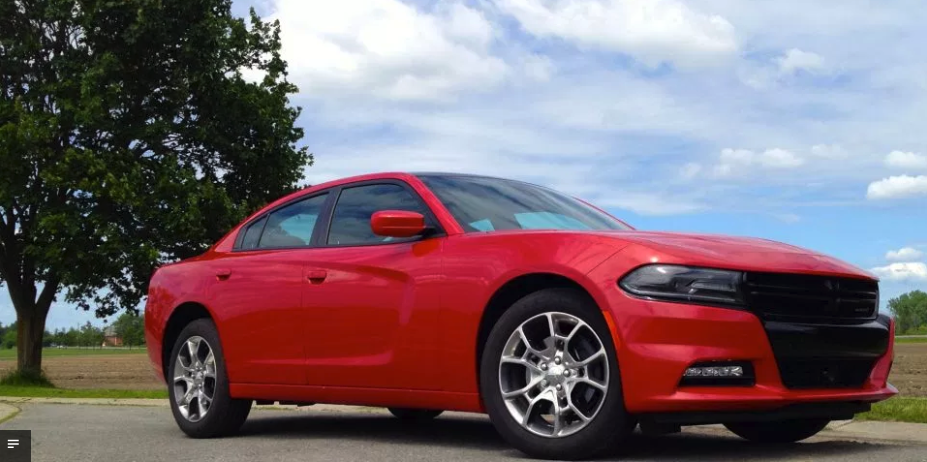Road Test: 2016 Dodge Charger SXT AWD

Story and photo by John LeBlanc
For the few remaining fans of full-size sedans in Canada, the 2016 Dodge Charger is their favourite. However, in a shrinking class that includes nameplates your grandparents are probably more familiar with – like the Chevrolet Impala, Ford Taurus or Toyota Avalon – is being the best-selling large car in the country relevant anymore?
Over the years, Dodge certainly has got its money’s worth from the Charger trademark. The first four generations between 1966 and 1987 were traditional Detroit pieces of iron, morphing from high-horsepower muscle cars to chrome-laden personal luxury coupes. The outlier fifth-gen mid-1980s’ Charger was a Volkswagen Scirocco coupe rip-off, based on front-wheel-drive Dodge Omni compact hatchback mechanicals. Finally, under the reign of Germany’s Daimler, the current Charger returned for 2005, this time as a four-door sedan based on an ageing rear- or all-wheel-drive Mercedes-Benz E-Class platform.
Of course, since its debut a decade ago, the market for big sedans has slid as far as the demand for crossovers and SUVs has risen. Much like its equally aged main rival, the fifth-generation Ford Taurus which has used the same Volvo-supplied platform since 2005, the Charger has had to suffice with a string of nips and tucks to keep it relevant in a market obsessed with utility vehicles.
The latest rounds of Charger updates came just last year, which saw 2015 models receive heavily updated exterior styling, an upgraded interior and some powertrain tweaks. For 2016, there are only minor changes in the lineup.
Despite its lack of freshness, much of the continuing popularity of the full-size Charger lays in its wide range of price and power.
The lineup starts with the $34,295 (base MSRP) rear-wheel-drive Charger SE and its 292-horsepower V6 and ends with the $78,340 Charger SRT Hellcat super sports sedan and its 707-horsepower Hemi V8. Thrown in for good measure are a gaggle of performance-oriented V8 models that harken back to Mopar’s muscle-car glory days
For those living in the present, with children to ferry around and perhaps a few more years (or decades) left on the mortgage, there’s my tester, the all-wheel-drive $39,595 Charger SXT AWD, a model that hits the sweet spot in the lineup in regards to performance, features and value.
In SXT AWD trim, the Charger already comes with a slew of standard gear, highlighted by a Uconnect 8.4-inch touchscreen, heated front seats, thick leather-wrapped steering wheel, automatic dual-zone climate control and an eight-speed automatic transmission (no manual is available).
In addition, my tester came with a $1,390 Rallye Appearance Group that added an upgraded sound system, paddle shifters and eight more horsepower and lb.-ft. of torque to the standard 3.6-litre V6, now rated at 300 horsepower and 264 lb.-ft., a boost via a new cold-air intake, exhaust and retuned engine management system.
As well, a $5,295 AWD Premium Group added a host of safety gear (blind-spot monitoring, rear cross-path detection, forward collision warning with active braking, lane-departure warning/lane keep assist, rear park assist, rear back-up camera) navigation and upgraded leather Sport seats that raised the as-tested price to just over $46,000.
Admittedly, the Charger SXT AWD takes about twice as along to get to highway speeds than its under-four-second SRT Hellcat brother. Compared to a similarly equipped all-wheel-drive $41,699 2016 Ford Taurus SEL, however, the big Dodge sedan offers 12 more horsepower and 10 more lb.-ft. As such, the Charger SXT AWD is 0.4 second quicker than a Taurus SEL AWD from zero to 100 km/h, taking just 6.8 seconds.
Having two more gears than the Ford’s six-speed autobox also allows the Dodge to claim “best in class” fuel economy estimates, rated at 12.8 L/100 km city and 8.6 highway, while the Ford chimes in at 13.0 and 9.1, respectively.
In my time in the Dodge, I did not get a chance to test out its AWD system in any of the snowy stuff. Unlike the Ford sedan’s front-drive-biased AWD system, though, the Charger acts like a rear-drive sedan when traction is available, as its system automatically disconnects at the front wheels when not needed.
The rest of the Charger SXT AWD’s driving experience was surprisingly sophisticated. Despite its age, the Dodge compares well not only to mainstream big sedan rivals but also to some pricier import brand metal.
First off, and like a lot of luxury sedan these days, the 2016 Charger SXT AWD comes with driver selectable modes: Normal, Comfort, Sport. Opt for the Rallye Package, though, and you get Dodge’s so-called Sport Mode II that delivers quicker gear changes (250 milliseconds vs. 400), a more aggressive throttle map and more steering feel.
Combined with an already beefy and well-controlled suspension, and the big Dodge four-door feels like it weighs less and takes up less room on the road than it actually does. It’s a stretch to call the Charger SXT AWD a “sports sedan,” but the car never feels sloppy or loose when pressed hard.
For the remaining 99 percent of the time where you need the Dodge to behave like a domesticated family sedan, its roomy cabin and quiet ride make commuting a surprisingly relaxing experience. Back seat passengers will also appreciate the Charger’s extra few inches of legroom it has over its Ford rival.
In the end, the biggest failure of the 2016 Dodge Charger SXT AWD is that it isn’t a crossover or SUV. With traction at all four wheels, plenty of room for five, excellent fuel economy and road manners that approach some pricier luxury sedans, the big Dodge is a great value and makes the case that the large car may not be dead just quite yet.




